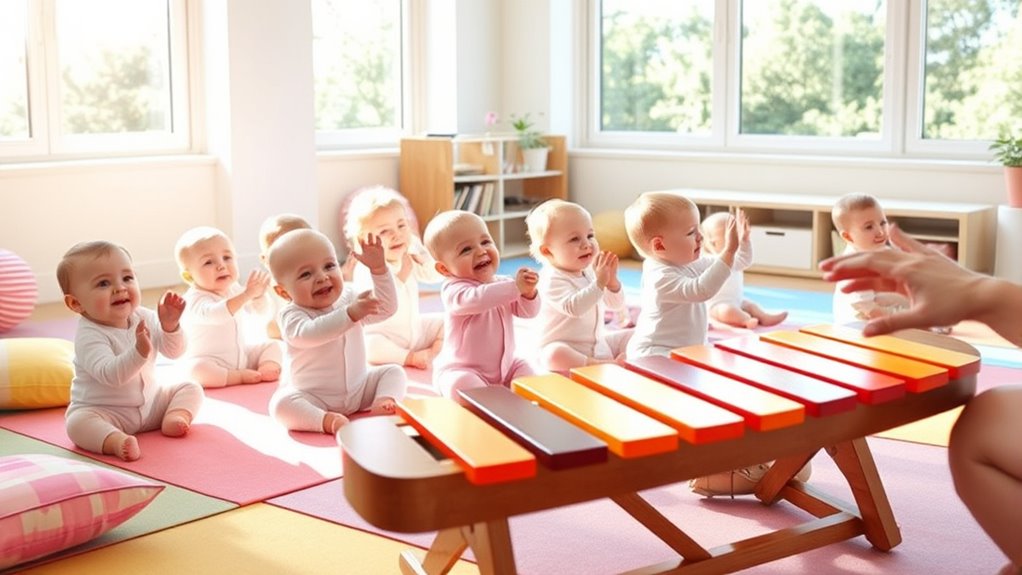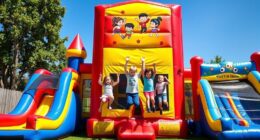Engaging your infant with music and movement boosts their sensory skills, helps develop rhythmic awareness, and encourages physical activity essential for growth. Through singing, bouncing, and gentle dancing, you strengthen their coordination, introduce them to patterns, and stimulate their senses. Using simple instruments and varied musical styles keeps their interest high and promotes exploration. Keep in mind, incorporating consistent activities can greatly benefit their development—if you stay tuned, you’ll discover even more ways to support their progress.
Key Takeaways
- Engaging infants with varied musical styles enhances sensory exploration and auditory development.
- Moving infants to music through bouncing and swaying supports physical coordination and rhythmic understanding.
- Using musical instruments like rattles fosters tactile and sound-based sensory experiences.
- Repeating musical activities helps infants recognize patterns and develop timing skills.
- Incorporating music and movement encourages body awareness, cognitive growth, and early motor milestones.

Introducing music and movement to infants can considerably support their development by engaging their senses and encouraging physical activity. When you incorporate rhythmic patterns into their environment, you help foster their rhythmic development, which is fundamental for later speech, coordination, and musical understanding. Rhythmic development isn’t just about keeping a beat; it involves the infant’s ability to recognize and respond to patterns of sounds and movements. By clapping, bouncing, or moving to a song, you give your baby opportunities to feel the beat through their body, which enhances their sense of timing and coordination. These activities also serve as a form of sensory exploration, allowing your infant to discover how different sounds, rhythms, and movements feel and interact. As they listen to music and watch you move, they begin to process how various stimuli are connected, strengthening their sensory pathways. Incorporating a variety of musical styles can further expand their auditory experiences and support sound recognition.
Engaging your infant in music and movement is simple, and it’s a powerful way to support their development. For instance, playing gentle lullabies or lively nursery rhymes invites your baby to listen actively, helping them distinguish different sounds and pitches. When you sway or bounce them along to the music, you’re not only providing physical stimulation but also creating a multisensory experience that benefits their brain development. Repetition of these activities is key; it helps infants recognize patterns and anticipate what comes next, further reinforcing their rhythmic understanding. As they grow, they become more adept at syncing their movements with the music, which lays the groundwork for coordinated motor skills.
You can encourage sensory exploration by introducing a variety of musical instruments designed for infants, like rattles or drums, which they can grasp and shake. These instruments allow them to experiment with different textures and sounds, deepening their sensory perception. Moving their arms, legs, or entire bodies to different tempos helps them understand the connection between movement and sound, fostering both physical and cognitive growth. Remember, every interaction with music and movement is an opportunity for your infant to learn about their own body and the world around them. The more you engage in these activities, the more you nurture their natural curiosity and support their developmental milestones. So, keep the rhythm flowing and the movements gentle—your participation makes all the difference in their sensory exploration and rhythmic development.
Frequently Asked Questions
How Does Music Aid Infant Brain Development?
You can enhance infant brain development by exposing them to music, which boosts brain plasticity and strengthens auditory processing skills. When infants listen to melodies, rhythms, and sounds, their brains adapt and form new neural connections. This active engagement helps improve cognitive abilities, language skills, and emotional regulation. By incorporating music into daily routines, you support their overall growth, making their developing brains more flexible and responsive to new experiences.
What Are the Best Instruments for Infants?
You should choose soft, safe instruments like rattles, shakers, and drums designed for infants. These align with their musical preferences, offering gentle sounds that soothe and engage. Coincidentally, these instruments prioritize safety, with no sharp edges or small parts, ensuring your baby can explore freely. By selecting age-appropriate, safe instruments, you foster their curiosity and love for music while keeping their safety top of mind.
How Can I Encourage Movement During Music Sessions?
You can encourage movement during music sessions by inviting infants to participate in rhythmic dancing and gentle bouncing. Use lively, engaging music to motivate them to sway, bounce, or wiggle along with the beat. Keep activities simple and fun, demonstrating movements yourself so they can mimic you. Offer lots of positive encouragement, and create a relaxed atmosphere where they feel free to explore movement naturally.
Are There Any Safety Concerns With Musical Toys?
You should always prioritize musical toy safety by choosing infant-proof instruments that are sturdy and free of small parts, which could pose choking hazards. Regularly inspect toys for damage or sharp edges, and verify they meet safety standards. Keep an eye on your infant during playtime to prevent accidents. By selecting age-appropriate, well-made instruments, you help create a safe environment that encourages musical exploration and movement.
How Does Movement Improve Infant Sleep Patterns?
You can turn the tide by incorporating gentle rocking and rhythmic bouncing to improve your infant’s sleep patterns. Movement helps soothe your baby, releasing tension and promoting relaxation. When you create a calming environment with gentle motions, it’s like hitting two birds with one stone—helping your little one fall asleep faster and enjoy deeper, more restorative sleep. This consistency builds a sense of security, making bedtime a peaceful part of your routine.
Conclusion
Incorporating music and movement into your infant’s routine nurtures their development and deepens your bond. These activities stimulate their senses, encourage motor skills, and foster emotional growth. Remember, a journey of a thousand miles begins with a single step—so start simple, stay consistent, and enjoy the rhythm of your little one’s progress. With patience and joy, you’ll witness their confidence blossom through these shared musical moments.










